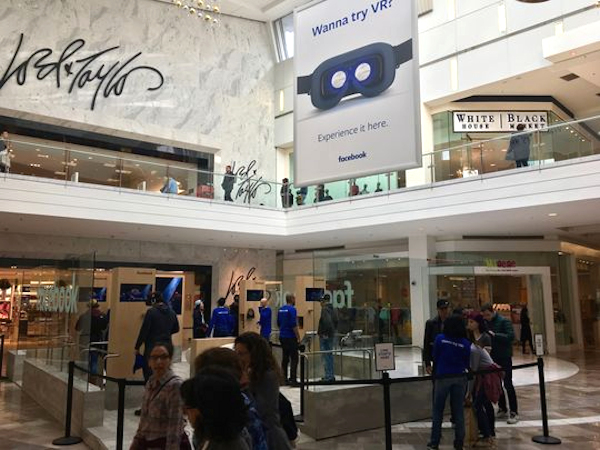[According to a recent Parks Associates marketing study, “more than 60% of U.S. broadband households claim to know little or nothing about virtual reality,” but “50% of consumers who try a VR headset enjoy it and make plans to purchase one, while 15% who try one enjoy the experience and then buy a headset.” So the Facebook pop-up ‘stores’ described in the story below from USA Today make sense. The original story includes a 0:27 minute video and more pictures, and coverage in The Denver Post has a list of the cities that are hosting the demos. –Matthew]

[Image: Facebook’s VR pop-up shop in Westfield Garden State Plaza in Paramus, NJ on November 25, 2016. (Photo: Eli Blumenthal, USA TODAY)]
Facebook pop-up stores offer taste of VR
Jessica Guynn, Trevor Hughes and Brett Molina, USA TODAY
Dec. 29, 2016
No, your eyes are not deceiving you. The Facebook store is real.
Consumers and travelers may have bumped into these pop-up Facebook “stores” over the holidays at airports and malls. What the stores are trying to sell is one of the tech sector’s hottest trends — virtual reality.
The stores are part of a virtual reality tour to introduce the tough-to-explain technology to the masses. They’re available in several big cities across the country, including Denver, New York, Phoenix and San Diego, through the end of January.
Customers visiting the stores can try out Gear VR, a virtual-reality headset created by Facebook-owned Oculus in partnership with Samsung. The devices works with models of Samsung’s Galaxy smartphones.
“Virtual reality is truly immersive and provides an incredible sense of presence which can be hard for people to imagine without a demo,” Facebook said in a statement. “We wanted to give people the opportunity to try Gear VR firsthand and experience the power of virtual reality.”
At the Denver International Airport display, a steady stream of travelers stopped in to test out the eight stations. Each guest gets a Facebook-assigned handler to walk them through the brief setup and then to make sure they don’t accidentally stumble or fall while undergoing the immersive experience.
Visitors watched a two-minute VR experience whisking them around the world and out beyond the stars, in a mix of real and computer-generated footage that includes basketball players, a short boat ride and getting plunked amid a circus.
“Whoa,” said John Jarvie, 30, as he watched a giant dinosaur nose toward him during a Jurassic Park-themed section. Afterward, Jarvie said he’d never tried VR before and was impressed: “Pretty rad, man.”
Robin Kahler, 52, said she told all her friends and family to try out VR after experiencing the Facebook display at the Denver airport. “I wanted to be able to touch the dinosaur,” she said. “It’s like you’re suddenly there. I would totally throw down $5 for a safari.”
Airport workers said the video experience Facebook first showed was actually too realistic, and a handful of viewers walked away dizzy, so a gentler video replaced it. Guests face multiple warning signs about the risks of motion sickness, each kiosk has a safety grab rail, and workers to monitor users while they’re wearing the goggles and headset isolating them from the real world.
The stores address a key issue with virtual reality: how to promote its potential to people who have never tried it.
“It’s all about the first step,” said Stephanie Llamas, director of research and insights at SuperData Research. “Once they take it, you open them to a world of possibilities they couldn’t have imagined. It’s a Matrix moment. But they can’t know the possibilities without being proactive, so companies not only have to make consumers aware but also make them feel like trying it was their own idea.”
Facebook CEO Mark Zuckerberg has been one of several big supporters of VR, hailing it as the next great computing platform. In 2014, Facebook acquired Oculus, the company sparking recent buzz surrounding VR with its Rift headset, for $2 billion.
Several companies have since entered the market with their own headsets, including Samsung, Sony with its recently-launched PlayStation VR — compatible with the PlayStation 4 video game console, and HTC’s Vive.
The headsets are popular among hard-core video game players, but have yet to make a major breakthrough to mainstream audiences. Price is one potential hurdle. For example, PlayStation VR is the most affordable of the high-end VR headsets at $399.99. Meanwhile, Oculus Rift and HTC Vive require powerful personal computers capable of running VR, which can add to the price.
Facebook is betting VR will deliver experiences well beyond gaming, including education and socially, such as grandparents watching a toddler’s first steps. During an appearance at February’s Mobile World Congress, Zuckerberg hailed VR as “the most social platform.”
“Pretty soon we’re going to live in a world where everyone has the power to share and experience whole scenes as if you’re just there, right there in person,” Zuckerberg said.